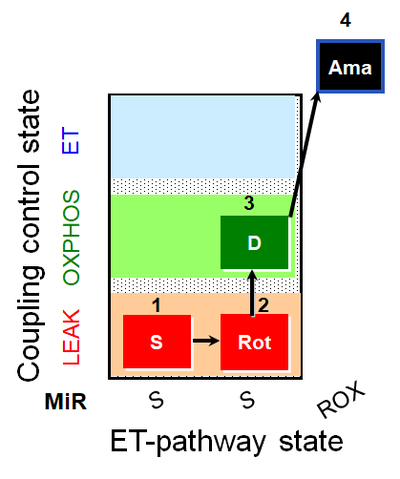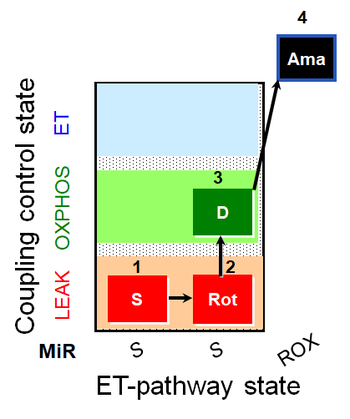Difference between revisions of "SUIT-026 AmR mt D064"
| Line 6: | Line 6: | ||
|SUIT number=D064_1S;2Rot;3D;4Ama | |SUIT number=D064_1S;2Rot;3D;4Ama | ||
}} | }} | ||
::: '''[[MitoPedia: SUIT]]''' - Protocol for | ::: '''[[MitoPedia: SUIT]]''' - Protocol for the evaluation of ROS production by RET in mtprep | ||
::: '''[[SUIT protocol pattern]]:''' 1S;2Rot;3D;4Ama | ::: '''[[SUIT protocol pattern]]:''' 1S;2Rot;3D;4Ama | ||
SUIT-026 AmR mt D064 has been designed to study the [[Reverse_electron_flow_from_CII_to_CI| RET]]-initiated ROS production in isolated mitochondria. The protocol is focused on [[LEAK]] state for the [[S-pathway]] to provide the conditions of high membrane potential and redox power in the Q-junction. Under these conditions, in several samples has been described that a reverse flow of the electrons into the membrane arm and the quinone binding site of the Complex I occurs, promoting the production of ROS. The addition of [[rotenone]] provides excellent control to this mechanism because this compound blocks the point on which the electrons leak from the Complex I leading to decreased ROS production. If rotenone would have been added before S titration, it had inhibited the RET. The titration of ADP at saturating concentrations to reach [[OXPHOS]] allows us to harmonize this protocol with [[ SUIT-006 O2 mt D022]] for quality control and a full assessment of the coupling control. Addition of [[Antimycin A|Ama]] leads to increased ROS production via inhibition of Complex III at the Qi site. | SUIT-026 AmR mt D064 has been designed to study the [[Reverse_electron_flow_from_CII_to_CI| RET]]-initiated ROS production in [[Mitochondrial preparations| mitochondrial preparations ([[Isolated mitochondria|isolated mitochondria]] and [[Tissue homogenate|tissue homogenate]] and [[Permeabilized cells|permeabilized cells]] which are already permeabilized when they are added to the chamber)]]. The protocol is focused on [[LEAK]] state for the [[S-pathway]] to provide the conditions of high membrane potential and redox power in the Q-junction. Under these conditions, in several samples has been described that a reverse flow of the electrons into the membrane arm and the quinone binding site of the Complex I occurs, promoting the production of ROS. The addition of [[rotenone]] provides excellent control to this mechanism because this compound blocks the point on which the electrons leak from the Complex I leading to decreased ROS production. If rotenone would have been added before S titration, it had inhibited the RET. The titration of ADP at saturating concentrations to reach [[OXPHOS]] allows us to harmonize this protocol with [[ SUIT-006 O2 mt D022]] for quality control and a full assessment of the coupling control. Addition of [[Antimycin A|Ama]] leads to increased ROS production via inhibition of Complex III at the Qi site. | ||
| Line 22: | Line 22: | ||
:::+ Short protocol. | :::+ Short protocol. | ||
:::+ Rotenone provides an excellent control step for RET. | :::+ Rotenone provides an excellent control step for RET. | ||
:::- | :::- This protocol does not provide information about all the coupling control states (LEAK, OXPHOS and ET). However, it is possible to create a [[Export DL-Protocol User (*.DLPU)|DLPU]] by additing an Event&Mark for the uncoupler titration (4U) after ADP (3D) to obtain ET-state. | ||
:::- The addition of cytochrome ''c'' cannot be done in this SUIT protocol. | |||
== Compare SUIT protocols == | == Compare SUIT protocols == | ||
::::* [[SUIT-026 O2 mt D063]]: Respiratory control protocol. | |||
::::* [[SUIT-006 O2 mt D022]]: CCP mtprep for S-pathway. | ::::* [[SUIT-006 O2 mt D022]]: CCP mtprep for S-pathway. | ||
Revision as of 14:33, 26 June 2019
Description
Abbreviation: RET
Reference: A - SUIT-026
SUIT number: D064_1S;2Rot;3D;4Ama
O2k-Application: AmR
- MitoPedia: SUIT - Protocol for the evaluation of ROS production by RET in mtprep
- SUIT protocol pattern: 1S;2Rot;3D;4Ama
SUIT-026 AmR mt D064 has been designed to study the RET-initiated ROS production in [[Mitochondrial preparations| mitochondrial preparations (isolated mitochondria and tissue homogenate and permeabilized cells which are already permeabilized when they are added to the chamber)]]. The protocol is focused on LEAK state for the S-pathway to provide the conditions of high membrane potential and redox power in the Q-junction. Under these conditions, in several samples has been described that a reverse flow of the electrons into the membrane arm and the quinone binding site of the Complex I occurs, promoting the production of ROS. The addition of rotenone provides excellent control to this mechanism because this compound blocks the point on which the electrons leak from the Complex I leading to decreased ROS production. If rotenone would have been added before S titration, it had inhibited the RET. The titration of ADP at saturating concentrations to reach OXPHOS allows us to harmonize this protocol with SUIT-006 O2 mt D022 for quality control and a full assessment of the coupling control. Addition of Ama leads to increased ROS production via inhibition of Complex III at the Qi site.
Communicated by Komlodi T, Iglesias-Gonzalez J and Gnaiger E (last update 2019-06-26)
Steps and respiratory states
| Step | State | Pathway | Q-junction | Comment - Events (E) and Marks (M) |
|---|---|---|---|---|
| 0DTPA |
| |||
| 0SOD |
| |||
| 0HRP |
| |||
| 0AmR |
|
| Step | State | Pathway | Q-junction | Comment - Events (E) and Marks (M) |
|---|---|---|---|---|
| 1S | SL(n) | S | CII | 1S
|
| 2Rot | SL(n) | S | CII | 1S;2Rot
|
| 3D | SP | S | CII | 1S;2Rot;3D
|
| 4Ama | ROX | 1S;2Rot;3D;4Ama
|
- Bioblast links: SUIT protocols - >>>>>>> - Click on [Expand] or [Collapse] - >>>>>>>
- Coupling control
- Pathway control
- Main fuel substrates
- » Glutamate, G
- » Glycerophosphate, Gp
- » Malate, M
- » Octanoylcarnitine, Oct
- » Pyruvate, P
- » Succinate, S
- Main fuel substrates
- Glossary
Strengths and limitations
- The conditions on which RET is observable in isolated mitochondria are not physiological but it has been suggested that corresponds to some pathological states.
- + This protocol must be run parallel with SUIT-026 O2 mt D063 to have a respiratory control.
- + Short protocol.
- + Rotenone provides an excellent control step for RET.
- - This protocol does not provide information about all the coupling control states (LEAK, OXPHOS and ET). However, it is possible to create a DLPU by additing an Event&Mark for the uncoupler titration (4U) after ADP (3D) to obtain ET-state.
- - The addition of cytochrome c cannot be done in this SUIT protocol.
Compare SUIT protocols
- SUIT-026 O2 mt D063: Respiratory control protocol.
- SUIT-006 O2 mt D022: CCP mtprep for S-pathway.
References
MitoPedia concepts: SUIT protocol, SUIT A, Find
MitoPedia methods:
Fluorometry



